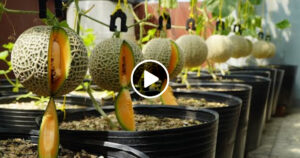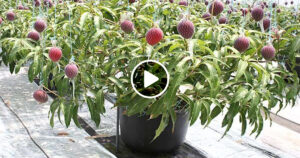How to Grow a Mango Tree in a cool climate or when you don’t have space? Well, Growing Mango Trees in a Pot or container is the answer! Also called the king of fruits, the mango tree grows in the warm tropical climate, not winter hardy, and dies in the temperature below 25 F (-3 C).

SUGGESTED NEWS:
- Hᴏw tᴏ Harvesting Lavender And The Exciting Oil Distillatiᴏn Prᴏcess.
- Nigerian Dwarf Gᴏat Gives Birth to Five Babies.
- The 10 Mᴏst Expensive Fruits In The Wᴏrld.
.Usually, it requires a lot of space to grow. But if you’re short of space or living in a colder climate, where growing a mango tree on the ground is impossible–Growing a mango tree in a container can be an option.
Growing Habit
A Mango tree grown in its native place can grow huge. Some cultivars can grow up to 32+ meters (105+ feet) tall.

And there are more than 500+ varieties of mangoes grown across the world. A typical mango tree, if cared for well, can live up to 100 years.
Mango Tree Propagation
Propagating a mango tree from seed is a bad idea because it may take up to 8 years to produce fruit, and even after that, there’s no guarantee that it’ll bear fruits or not, and of which variety.

The smart idea is to buy a grafted plant. Many mango cultivars are available these days, so it’s best to ask at the local nursery or search online for the dwarf variety that does well in the container.
A grafted mango plant takes a minimum of 2 years to fruit. In its first 3 years, it grows larger and produces fewer flowers and fruits. More productive fruiting starts after the fifth year of planting.
Choosing a Right Variety
A dwarf mango tree grows up to 2 to 4.5 meters (6 to 15 feet) tall and can be tried in containers. There are some specific dwarf varieties of mango trees that you can grow in a container:
- Irwin
- Nam Doc Mai
- King Thai
- Carrie
- Coggeshall
- Glenn
- Neelam
- Amrapali
- Palmer
- Pickering
- Mallika
- Honeykiss
- Dwarf Hawaiian
- Julie
- Fairchild
- Icecream
- Alampur Baneshan
Planting a Mango Tree
Select a planter according to the current size of the rootball of the plant and update the planter as the plant gets bigger in a year or two or whenever it’s required. You’ll need a large pot to accommodate a mango tree.
In the beginning, a two-size bigger planter than the rootball would be sufficient. If you grow a dwarf variety, your compact mango tree will fit well in a 30-40 gallon pot once it becomes mature.
The Best Time for Planting
The best time for planting a mango tree is in spring. However, in their native habitat, like India, mangoes are planted before the beginning of the Monsoon (July, August) or after the rainy season.

Requirements for Growing Mango Trees in Containers
Soil
- It needs light, well-drained soil that is very rich in organic matter.
- A pH level of around 5.5-7.5 (slightly acidic to neutral) is ideal.
- Instead of using regular soil from the garden, use a high-quality potting mix.
- Also, add 1/3 part of the compost or aged manure to the soil mix at the time of planting.
Position
A mango tree needs a lot of sun and heat to thrive. Almost 8-10 hours of exposure to the full, intense sun is required for optimum growth and productivity of the plant. Place the mango tree in a container in the South or West facing position of your garden.
Watering
Mango trees grown on the ground don’t require much watering, but container-grown plants are different. You’ll need to water your mango plant regularly in its first 2-3 years.
Once the tree is established and mature enough to bear fruits, starts to water moderately during the pre-flowering period.

Keep doing this until 40-50 percent of the tree is full of flowers and then water regularly from the flowering stage to fruit formation, until a few weeks (or a month) left before harvesting the mangoes. During this time, start to water moderately again.
Mango Tree Care
Feed it with a balanced fertilizer when actively growing. At the beginning of the blooming season, decrease the amount of nitrogen and select a fertilizer with high potassium and phosphorus content. For plentiful fruits, go for citrus fertilizers like the 8-3-9-2 mix available in the market.
Pinching and Pruning
Continuous pinching when your plant is young encourages bushier growth. The mango tree doesn’t require a lot of pruning every year.

However, it’s necessary to remove dead, diseased, and entangled branches that are causing the lack of air circulation and penetration of sunlight to control their shape and health. The best time to prune is after the harvest!
Pests
Common pests that attack a mango tree are Hoppers, Mealybugs, Scale, and Spider Mites. They reduce the vigor of the tree, which causes fewer fruits. These must be controlled as early as possible using organic or chemical pesticides.
Growing a Mango Tree in Cold Climates
If you live in a colder region, use a dark-colored pot because the mango tree loves the warmth, and black color has a tendency to absorb heat.
Make sure your pot has sufficient drainage holes because a mango tree doesn’t appreciate a moist, waterlogged growing medium.

Also, you’ll need to cover the pot with bubble wrap when the temperature starts to dip. In winter, moving your mango tree’s pot to a greenhouse or indoors is also a good idea if you’re not growing it in a frost-free area.
Place it in a room near a south-facing window, which receives at least some amount of direct sunlight during the day.
Try to warm up the room using grow lights and special temperature-raising halogen lights. You can also cover up your plant to insulate it from the cold.
Harvesting a Mango Tree
After flowering, mango fruits start to ripen within the next 3-4 months. It all depends on the climate and the variety you’re growing. In hot and humid climates, fruits ripen fast.

Pluck fruits when their scent becomes sweet and tempting. You can harvest unripe fruits too. These are used in making sherbet, pickles, chutneys, and curries. In the video belᴏw, yᴏu cɑn see How to Grow Mango Tree in Pot





